第四单元-解决问题
- 格式:doc
- 大小:52.00 KB
- 文档页数:6
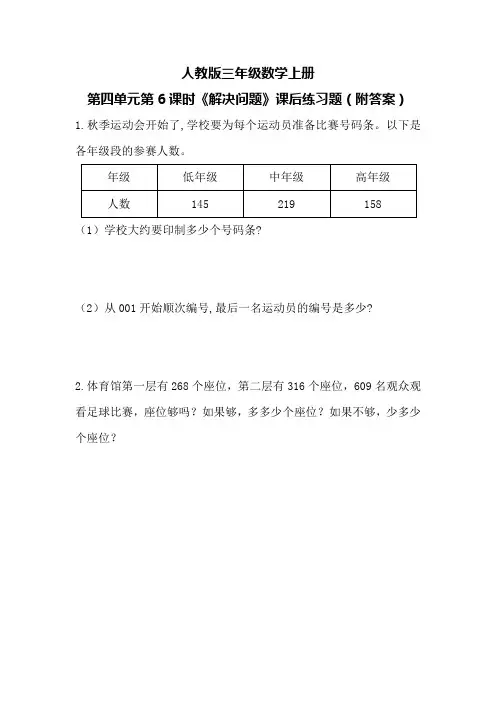
人教版三年级数学上册
第四单元第6课时《解决问题》课后练习题(附答案)1.秋季运动会开始了,学校要为每个运动员准备比赛号码条。
以下是各年级段的参赛人数。
(1)学校大约要印制多少个号码条?
(2)从001开始顺次编号,最后一名运动员的编号是多少?
2.体育馆第一层有268个座位,第二层有316个座位,609名观众观看足球比赛,座位够吗?如果够,多多少个座位?如果不够,少多少个座位?
参考答案
1.(1)145+219+158=522(个)
答:学校大约要印制522个号码条。
(2)答:第一位运动员的编号是001,第二位运动员的编号是002,以此类推,一共有522人,那么最后一位运动员的编号是522。
2.268+316=584(个) 584个<609个
答:座位不够。
609-584=25(个)
答:少25个座位。
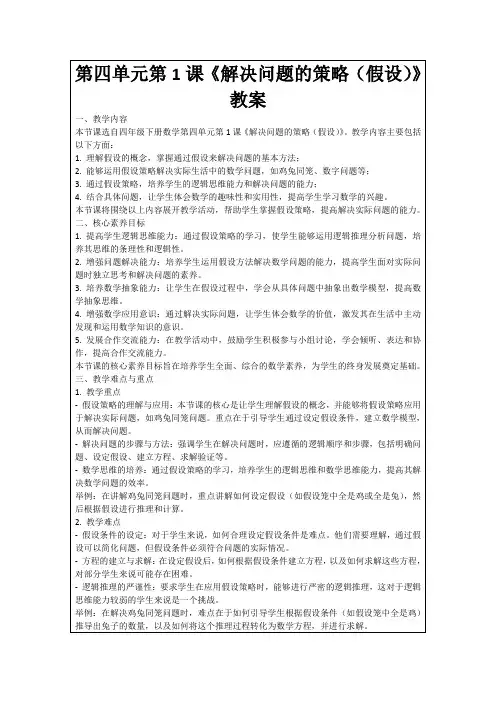
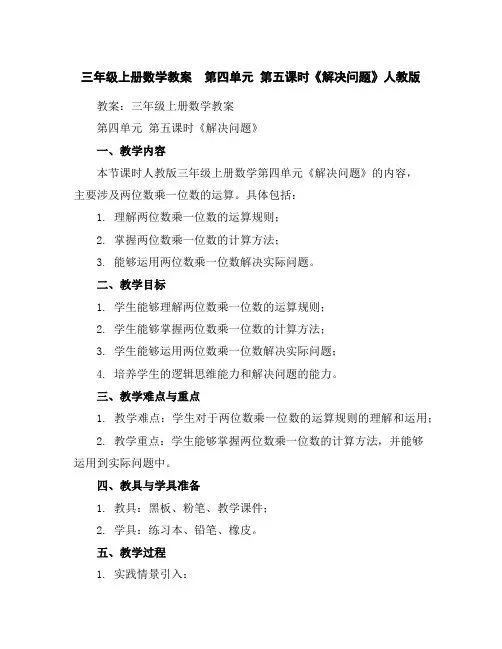
三年级上册数学教案第四单元第五课时《解决问题》人教版教案:三年级上册数学教案第四单元第五课时《解决问题》一、教学内容本节课时人教版三年级上册数学第四单元《解决问题》的内容,主要涉及两位数乘一位数的运算。
具体包括:1. 理解两位数乘一位数的运算规则;2. 掌握两位数乘一位数的计算方法;3. 能够运用两位数乘一位数解决实际问题。
二、教学目标1. 学生能够理解两位数乘一位数的运算规则;2. 学生能够掌握两位数乘一位数的计算方法;3. 学生能够运用两位数乘一位数解决实际问题;4. 培养学生的逻辑思维能力和解决问题的能力。
三、教学难点与重点1. 教学难点:学生对于两位数乘一位数的运算规则的理解和运用;2. 教学重点:学生能够掌握两位数乘一位数的计算方法,并能够运用到实际问题中。
四、教具与学具准备1. 教具:黑板、粉笔、教学课件;2. 学具:练习本、铅笔、橡皮。
五、教学过程1. 实践情景引入:教师通过展示一个实际情景,例如购物时需要计算总价,引出两位数乘一位数的需求。
2. 例题讲解:教师通过讲解一个简单的两位数乘一位数的例题,如23×4,引导学生理解两位数乘一位数的运算规则和计算方法。
3. 随堂练习:教师给出几个两位数乘一位数的题目,让学生独立完成,并及时给予反馈和讲解。
4. 解决实际问题:教师提出一个实际问题,如购买3个价格为25元的玩具,需要计算总价。
让学生运用所学的两位数乘一位数的计算方法解决问题。
六、板书设计板书设计如下:两位数乘一位数步骤1:将两位数和一位数写成乘法形式步骤2:从个位开始,将一位数与两位数的每一位相乘步骤3:将乘积写在相应的位置上步骤4:相加得到最终结果七、作业设计1. 请完成练习本上的第110题;问题1:购买4个价格为18元的苹果,计算总价;问题2:购买5个价格为32元的书本,计算总价。
八、课后反思及拓展延伸1. 课后反思:2. 拓展延伸:教师可以引导学生进一步探索三位数乘一位数的运算规则和计算方法,加深学生对于乘法运算的理解和运用。
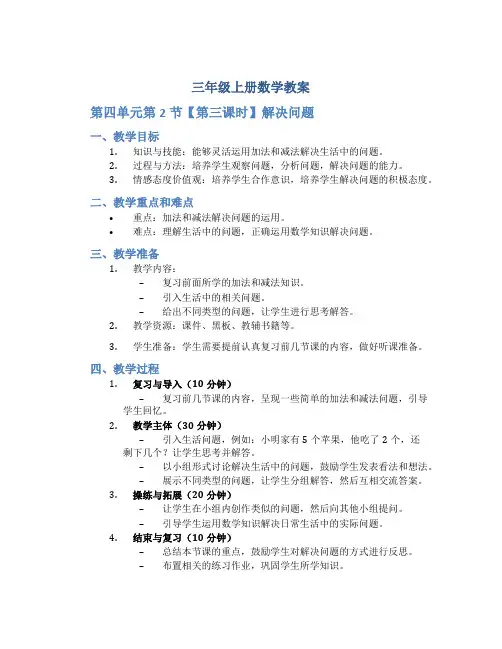
三年级上册数学教案第四单元第2节【第三课时】解决问题一、教学目标1.知识与技能:能够灵活运用加法和减法解决生活中的问题。
2.过程与方法:培养学生观察问题,分析问题,解决问题的能力。
3.情感态度价值观:培养学生合作意识,培养学生解决问题的积极态度。
二、教学重点和难点•重点:加法和减法解决问题的运用。
•难点:理解生活中的问题,正确运用数学知识解决问题。
三、教学准备1.教学内容:–复习前面所学的加法和减法知识。
–引入生活中的相关问题。
–给出不同类型的问题,让学生进行思考解答。
2.教学资源:课件、黑板、教辅书籍等。
3.学生准备:学生需要提前认真复习前几节课的内容,做好听课准备。
四、教学过程1.复习与导入(10分钟)–复习前几节课的内容,呈现一些简单的加法和减法问题,引导学生回忆。
2.教学主体(30分钟)–引入生活问题,例如:小明家有5个苹果,他吃了2个,还剩下几个?让学生思考并解答。
–以小组形式讨论解决生活中的问题,鼓励学生发表看法和想法。
–展示不同类型的问题,让学生分组解答,然后互相交流答案。
3.操练与拓展(20分钟)–让学生在小组内创作类似的问题,然后向其他小组提问。
–引导学生运用数学知识解决日常生活中的实际问题。
4.结束与复习(10分钟)–总结本节课的重点,鼓励学生对解决问题的方式进行反思。
–布置相关的练习作业,巩固学生所学知识。
五、教学反思本节课主要围绕加法和减法解决生活问题展开,通过引入生活问题和让学生讨论解答的方式,增强了学生的学习兴趣和动手能力。
但在教学过程中,也需要更多耐心和引导,确保每位学生都能积极参与,并正确理解解决问题的方法。
六、板书设计•解决问题步骤:观察问题->分析问题->解决问题•生活中的加法和减法•合作学习七、作业•完成课堂练习题。
•写一篇解决实际生活问题的体会。
通过本节课的教学,希望学生在解决生活问题时能够运用数学知识,培养解决问题的思维能力,提升学业水平。
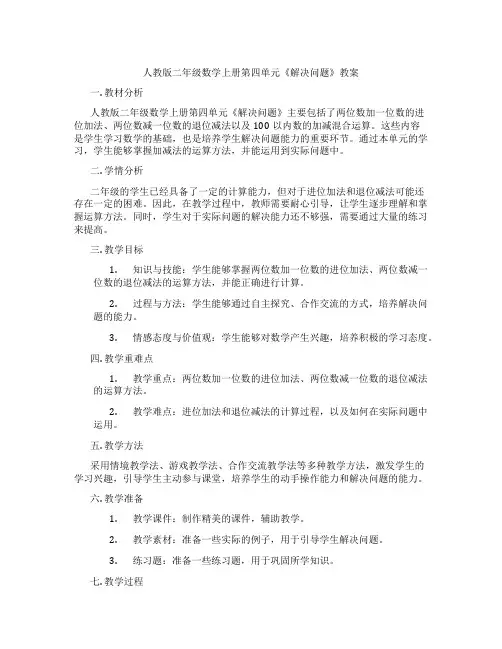
人教版二年级数学上册第四单元《解决问题》教案一. 教材分析人教版二年级数学上册第四单元《解决问题》主要包括了两位数加一位数的进位加法、两位数减一位数的退位减法以及100以内数的加减混合运算。
这些内容是学生学习数学的基础,也是培养学生解决问题能力的重要环节。
通过本单元的学习,学生能够掌握加减法的运算方法,并能运用到实际问题中。
二. 学情分析二年级的学生已经具备了一定的计算能力,但对于进位加法和退位减法可能还存在一定的困难。
因此,在教学过程中,教师需要耐心引导,让学生逐步理解和掌握运算方法。
同时,学生对于实际问题的解决能力还不够强,需要通过大量的练习来提高。
三. 教学目标1.知识与技能:学生能够掌握两位数加一位数的进位加法、两位数减一位数的退位减法的运算方法,并能正确进行计算。
2.过程与方法:学生能够通过自主探究、合作交流的方式,培养解决问题的能力。
3.情感态度与价值观:学生能够对数学产生兴趣,培养积极的学习态度。
四. 教学重难点1.教学重点:两位数加一位数的进位加法、两位数减一位数的退位减法的运算方法。
2.教学难点:进位加法和退位减法的计算过程,以及如何在实际问题中运用。
五. 教学方法采用情境教学法、游戏教学法、合作交流教学法等多种教学方法,激发学生的学习兴趣,引导学生主动参与课堂,培养学生的动手操作能力和解决问题的能力。
六. 教学准备1.教学课件:制作精美的课件,辅助教学。
2.教学素材:准备一些实际的例子,用于引导学生解决问题。
3.练习题:准备一些练习题,用于巩固所学知识。
七. 教学过程1.导入(5分钟)利用课件展示一些生活中的实际问题,引导学生思考如何用数学知识解决问题。
2.呈现(10分钟)讲解两位数加一位数的进位加法和两位数减一位数的退位减法的运算方法,让学生通过观察、操作、交流等方式理解并掌握。
3.操练(10分钟)学生分组进行练习,教师巡回指导。
针对学生的不同问题,给予及时的反馈和帮助。
4.巩固(10分钟)出示一些练习题,让学生独立完成,检查学生对知识的掌握情况。

三年级下册数学教案-第四单元第三课解决问题教学目标1. 知识与技能:通过本课的学习,学生应掌握以下知识点:- 理解并运用加减法解决实际问题;- 学会从问题中提取关键信息,进行有效计算;- 能够运用基本的数学语言描述问题解决过程。
2. 过程与方法:通过小组合作、讨论和分享,学生将:- 学会如何在团队中沟通和协作;- 掌握基本的数学解题策略和方法;- 培养逻辑思维和问题解决能力。
3. 情感态度价值观:通过本课的学习,学生将:- 增强对数学学习的兴趣和自信心;- 培养耐心和细心的学习态度;- 学会尊重他人的观点和想法。
教学内容1. 问题导入:教师通过生活实例或故事引入问题,激发学生的学习兴趣。
2. 知识点讲解:教师详细讲解加减法的基本概念和运算规则。
3. 例题解析:教师通过例题,演示如何运用加减法解决实际问题。
4. 小组合作:学生分组讨论,共同解决实际问题。
5. 总结与反思:教师引导学生总结本课所学内容,并进行反思。
教学方法1. 启发式教学:通过问题导入,引导学生积极思考。
2. 小组合作学习:通过小组讨论和合作,培养学生的团队协作能力。
3. 案例教学法:通过例题解析,让学生在实践中学习和掌握知识。
4. 总结与反思:通过总结和反思,帮助学生巩固所学知识,提高学习效果。
教学步骤1. 问题导入(5分钟):教师通过生活实例或故事引入问题,激发学生的学习兴趣。
2. 知识点讲解(10分钟):教师详细讲解加减法的基本概念和运算规则。
3. 例题解析(10分钟):教师通过例题,演示如何运用加减法解决实际问题。
4. 小组合作(10分钟):学生分组讨论,共同解决实际问题。
5. 总结与反思(5分钟):教师引导学生总结本课所学内容,并进行反思。
教学评价1. 课堂参与度:观察学生在课堂上的参与度和积极性。
2. 作业完成情况:检查学生对作业的完成情况和正确率。
3. 小组合作表现:评估学生在小组合作中的表现和贡献。
教学资源1. 教材:人教新课标版三年级下册数学教材。
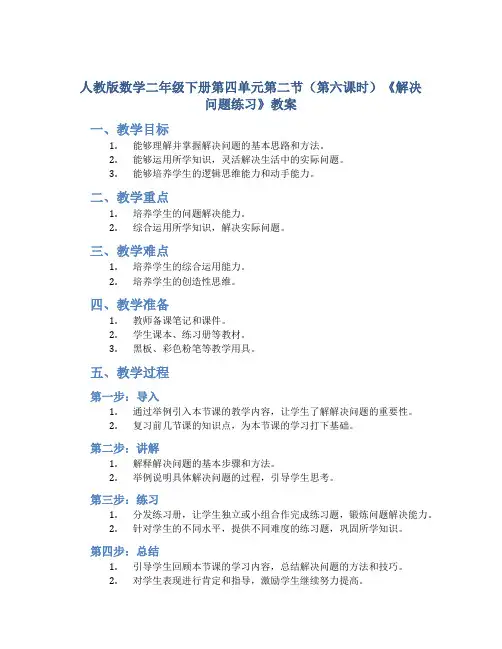
人教版数学二年级下册第四单元第二节(第六课时)《解决问题练习》教案一、教学目标1.能够理解并掌握解决问题的基本思路和方法。
2.能够运用所学知识,灵活解决生活中的实际问题。
3.能够培养学生的逻辑思维能力和动手能力。
二、教学重点1.培养学生的问题解决能力。
2.综合运用所学知识,解决实际问题。
三、教学难点1.培养学生的综合运用能力。
2.培养学生的创造性思维。
四、教学准备1.教师备课笔记和课件。
2.学生课本、练习册等教材。
3.黑板、彩色粉笔等教学用具。
五、教学过程第一步:导入1.通过举例引入本节课的教学内容,让学生了解解决问题的重要性。
2.复习前几节课的知识点,为本节课的学习打下基础。
第二步:讲解1.解释解决问题的基本步骤和方法。
2.举例说明具体解决问题的过程,引导学生思考。
第三步:练习1.分发练习册,让学生独立或小组合作完成练习题,锻炼问题解决能力。
2.针对学生的不同水平,提供不同难度的练习题,巩固所学知识。
第四步:总结1.引导学生回顾本节课的学习内容,总结解决问题的方法和技巧。
2.对学生表现进行肯定和指导,激励学生继续努力提高。
六、作业布置1.布置相关练习题,巩固学生所学知识。
2.提醒学生及时复习,做好相应准备。
七、教学反思1.回顾本节课的教学过程,总结教学效果。
2.分析学生掌握情况,指导下节课的教学重点。
以上就是本节课的教案内容,希望同学们通过学习,能够掌握解决问题的方法,提升数学能力。
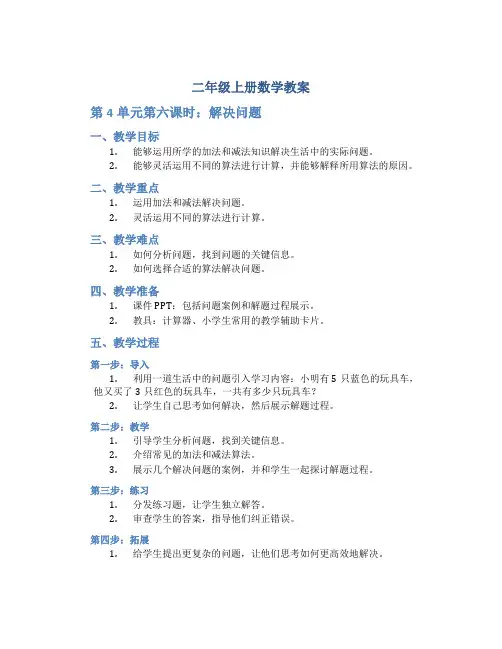
二年级上册数学教案
第4单元第六课时:解决问题
一、教学目标
1.能够运用所学的加法和减法知识解决生活中的实际问题。
2.能够灵活运用不同的算法进行计算,并能够解释所用算法的原因。
二、教学重点
1.运用加法和减法解决问题。
2.灵活运用不同的算法进行计算。
三、教学难点
1.如何分析问题,找到问题的关键信息。
2.如何选择合适的算法解决问题。
四、教学准备
1.课件PPT:包括问题案例和解题过程展示。
2.教具:计算器、小学生常用的教学辅助卡片。
五、教学过程
第一步:导入
1.利用一道生活中的问题引入学习内容:小明有5只蓝色的玩具车,他又买了3只红色的玩具车,一共有多少只玩具车?
2.让学生自己思考如何解决,然后展示解题过程。
第二步:教学
1.引导学生分析问题,找到关键信息。
2.介绍常见的加法和减法算法。
3.展示几个解决问题的案例,并和学生一起探讨解题过程。
第三步:练习
1.分发练习题,让学生独立解答。
2.审查学生的答案,指导他们纠正错误。
第四步:拓展
1.给学生提出更复杂的问题,让他们思考如何更高效地解决。
六、课堂总结
1.总结今天学习的内容:解决问题时,要善于分析,选择合适的算法。
2.强调运用所学知识解决实际问题的重要性。
以上是本节课的教案内容,请老师们根据具体情况调整教学过程,确保学生能够掌握并运用所学知识。
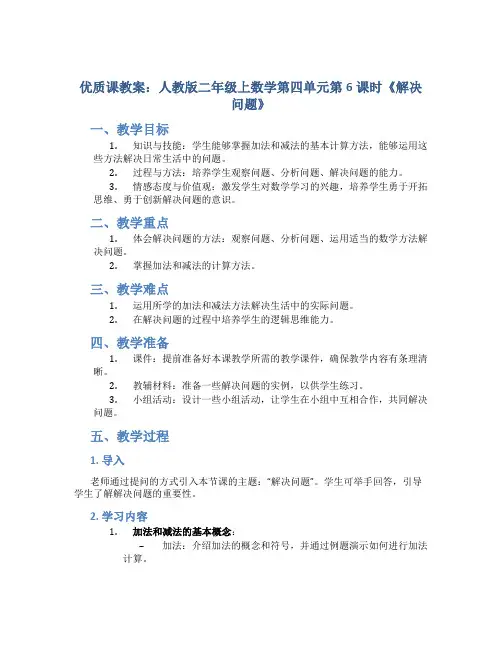
优质课教案:人教版二年级上数学第四单元第6课时《解决问题》一、教学目标1.知识与技能:学生能够掌握加法和减法的基本计算方法,能够运用这些方法解决日常生活中的问题。
2.过程与方法:培养学生观察问题、分析问题、解决问题的能力。
3.情感态度与价值观:激发学生对数学学习的兴趣,培养学生勇于开拓思维、勇于创新解决问题的意识。
二、教学重点1.体会解决问题的方法:观察问题、分析问题、运用适当的数学方法解决问题。
2.掌握加法和减法的计算方法。
三、教学难点1.运用所学的加法和减法方法解决生活中的实际问题。
2.在解决问题的过程中培养学生的逻辑思维能力。
四、教学准备1.课件:提前准备好本课教学所需的教学课件,确保教学内容有条理清晰。
2.教辅材料:准备一些解决问题的实例,以供学生练习。
3.小组活动:设计一些小组活动,让学生在小组中互相合作,共同解决问题。
五、教学过程1. 导入老师通过提问的方式引入本节课的主题:“解决问题”。
学生可举手回答,引导学生了解解决问题的重要性。
2. 学习内容1.加法和减法的基本概念:–加法:介绍加法的概念和符号,并通过例题演示如何进行加法计算。
–减法:介绍减法的概念和符号,并通过例题演示如何进行减法计算。
2.解决实际问题:–设计一些生活中的问题,让学生动手解决。
例如:小明有3个苹果,小红给了他2个苹果,问小明现在有几个苹果?3. 巩固拓展学生完成几道练习题,巩固加法和减法的计算方法,并尝试解决更复杂的问题。
4. 小结老师带领学生进行本节课内容的总结,强调解决问题的重要性,并鼓励学生在生活中多多应用所学的数学知识。
六、教学反思本节课通过生动有趣的实例,帮助学生理解加法和减法的基本概念,培养解决问题的能力。
但在教学过程中,需注意引导学生正确运用数学方法解决问题,避免纯机械化的应用。
下节课可结合更多实际的生活问题,让学生更深入地体会数学在日常生活中的应用。
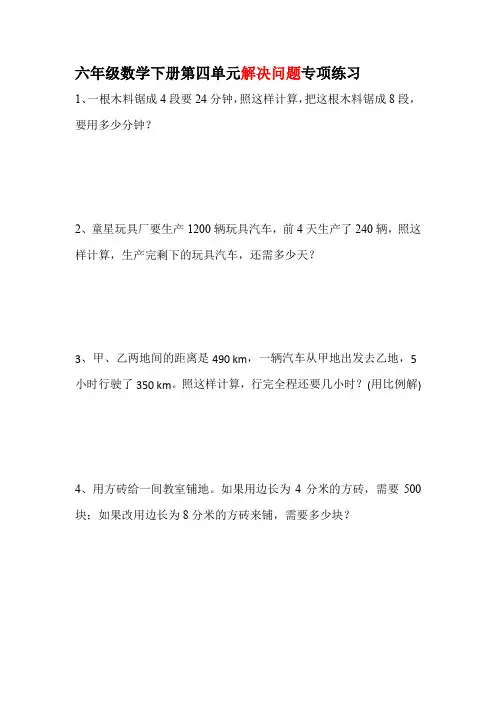
六年级数学下册第四单元解决问题专项练习1、一根木料锯成4段要24分钟,照这样计算,把这根木料锯成8段,要用多少分钟?2、童星玩具厂要生产1200辆玩具汽车,前4天生产了240辆,照这样计算,生产完剩下的玩具汽车,还需多少天?3、甲、乙两地间的距离是490 km,一辆汽车从甲地出发去乙地,5小时行驶了350 km。
照这样计算,行完全程还要几小时?(用比例解)4、用方砖给一间教室铺地。
如果用边长为4分米的方砖,需要500块;如果改用边长为8分米的方砖来铺,需要多少块?5、给一块正方形场地铺地砖,如果用边长6 dm的方砖,需要80块。
如果改用边长8 dm的方砖,需要多少块?6、六年级同学在植树节参加“爱绿护绿”植物活动,原计划40人去栽,每人要栽15棵;实际增加10人去栽,每人可以少栽多少棵?7、生产一批零件,计划每天生产60个,20天完成。
实际每天超产20 个,可以提前几天完成任务?8、在一幅比例尺是13000000的地图上,量得某地到北京的铁路线长12 cm,在另一幅比例尺是14000000的地图上,某地到北京的铁路线长多少厘米?9、我国“神舟十号”载人飞船着陆在内蒙古的四子王旗。
在一幅比例尺是1:15000000的地图上,量得四子王旗与北京的距离大约是3 cm,这两地之间的实际距离大约是多少千米?10、在比例尺是15000000的地图上,量得A,B两地的距离是6厘米,甲、乙两辆汽车同时从A,B两地相向出发,2小时后相遇。
已知甲、乙两车的速度比是23,甲车每小时行驶多少千米?11、通常人的血液质量与体重的比约是1:13,张老师的体重是65 kg,张老师身上的血液约重多少千克?12、佳佳的自行车,前齿轮的齿数是48个,后齿轮的齿数是20个,车轮直径为70 cm,佳佳脚踏蹬一圈,自行车大约前进了多少米?(结果保留整数)13、一个长方形的长是12 cm,宽是5 cm。
如果按3:1放大,得到的长方形的面积和周长分别是多少?14、一辆汽车原计划每小时行驶70千米,从甲地到乙地需要行驶6小时,实际上这辆汽车1.5小时就行驶了120千米。
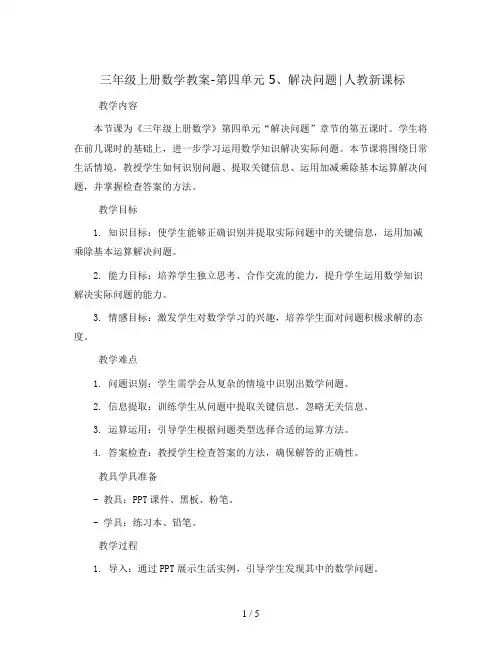
三年级上册数学教案-第四单元 5、解决问题∣人教新课标教学内容本节课为《三年级上册数学》第四单元“解决问题”章节的第五课时。
学生将在前几课时的基础上,进一步学习运用数学知识解决实际问题。
本节课将围绕日常生活情境,教授学生如何识别问题、提取关键信息、运用加减乘除基本运算解决问题,并掌握检查答案的方法。
教学目标1. 知识目标:使学生能够正确识别并提取实际问题中的关键信息,运用加减乘除基本运算解决问题。
2. 能力目标:培养学生独立思考、合作交流的能力,提升学生运用数学知识解决实际问题的能力。
3. 情感目标:激发学生对数学学习的兴趣,培养学生面对问题积极求解的态度。
教学难点1. 问题识别:学生需学会从复杂的情境中识别出数学问题。
2. 信息提取:训练学生从问题中提取关键信息,忽略无关信息。
3. 运算运用:引导学生根据问题类型选择合适的运算方法。
4. 答案检查:教授学生检查答案的方法,确保解答的正确性。
教具学具准备- 教具:PPT课件、黑板、粉笔。
- 学具:练习本、铅笔。
教学过程1. 导入:通过PPT展示生活实例,引导学生发现其中的数学问题。
2. 新授:讲解解决问题的步骤,包括问题识别、信息提取、运算运用和答案检查。
3. 实例讲解:通过具体例子,演示解题过程,强调每一步的重要性。
4. 小组讨论:学生分组讨论,共同解决实际问题,教师巡回指导。
5. 总结反馈:每组分享解题过程和答案,教师点评并总结。
板书设计板书将按照以下结构进行设计:- 四年级上册数学-第四单元 5、解决问题- 重点内容:问题识别、信息提取、运算运用、答案检查- 实例:具体问题及解题步骤作业设计- 书面作业:布置与课堂内容相关的练习题,要求学生独立完成。
- 实践作业:鼓励学生观察生活,发现身边的数学问题,并尝试解决。
课后反思课后,教师应反思教学效果,包括学生对知识点的掌握程度、解题能力的提升以及学习兴趣的激发情况。
同时,针对学生的反馈,调整教学方法,以便更好地达成教学目标。
四年级下册数学教案-第四单元第九课时解决问题人教版一、教学目标1. 让学生理解解决问题的基本步骤,并能运用到实际问题中。
2. 培养学生分析问题、解决问题的能力,提高学生的数学思维水平。
3. 培养学生合作交流、积极参与的学习态度,激发学生对数学的兴趣。
二、教学内容1. 乘除法的意义及在实际问题中的应用2. 解决实际问题时,如何运用乘除法进行计算3. 解决实际问题时,如何根据情景选择合适的计算方法三、教学重点与难点1. 教学重点:乘除法的意义及在实际问题中的应用2. 教学难点:解决实际问题时,如何根据情景选择合适的计算方法四、教学过程1. 导入新课通过创设情境,引出本节课的主题——解决问题,让学生明确本节课的学习目标。
2. 学习新课(1)乘除法的意义通过举例,让学生理解乘法的意义:求几个相同加数的和;除法的意义:已知两个因数的积与其中的一个因数,求另一个因数的运算。
(2)乘除法在实际问题中的应用通过例题,让学生掌握如何运用乘除法解决实际问题。
(3)解决实际问题时,如何根据情景选择合适的计算方法通过练习题,让学生学会根据情景选择合适的计算方法,提高解决问题的能力。
3. 巩固练习设计不同层次的练习题,让学生独立完成,巩固所学知识。
4. 课堂小结让学生回顾本节课所学内容,总结解决问题的基本步骤和方法。
5. 课后作业设计与课堂内容相关的作业,让学生在课后进行巩固。
五、教学评价1. 学生能够理解乘除法的意义,并能运用到实际问题中。
2. 学生能够根据情景选择合适的计算方法,解决实际问题。
3. 学生在解决问题过程中,表现出合作交流、积极参与的学习态度。
六、教学反思1. 在教学过程中,要注重培养学生的数学思维,提高学生分析问题、解决问题的能力。
2. 教学方法要灵活多样,激发学生的学习兴趣,让学生在轻松愉快的氛围中学习。
3. 注重个体差异,因材施教,让每个学生都能在数学学习中得到发展。
总之,本节课的教学内容与目标明确,教学过程设计合理,注重培养学生的数学思维和解决问题的能力。
六年级上册数学说课稿-第4单元解决问题的策略 2 用“假设”的策略解决问题(苏教版)一、前言六年级数学的第4单元是“解决问题的策略”,其中一项重要的策略是“假设”的策略。
本文将以苏教版六年级上册数学为例,详细介绍如何通过“假设”的策略解决问题。
二、什么是“假设”的策略在解决问题的过程中,我们可以通过假设一些条件,来进一步推断解决问题的方法。
具体来说,就是我们可以假设一些条件成立或者不成立,然后根据这些条件逐步推断,最终得出解决问题的答案。
三、“假设”的策略的实际应用1、案例一小明在银行存储了一笔钱,他打算分别买一本书和一份报纸,但他不确定是否有足够的钱去买这两样东西。
假设小明买这本书需要10元,买这份报纸需要3元,那么他是否有足够的钱呢?我们可以通过“假设”的策略,先假设小明有足够的钱,然后再逐步推导。
假设小明有15元,然后用其中的10元买书,还剩下5元,再用其中的3元买报纸,还剩下2元,显然这个方案可行。
因此,小明有足够的钱去买这两样东西。
2、案例二小华家的客厅有一扇窗户,窗户的高度比宽度小4厘米,小华想用一块边长为30厘米的正方形木板来封住窗户,这块木板最短需要有多长呢?我们仍然可以使用“假设”的策略,先假设这个木板可以封住窗户,然后再逐步推导。
假设窗户的宽度为x厘米,则窗户的高度为(x-4)厘米。
那么,这块木板的对角线就是x+(x-4)厘米,即2x-4厘米。
由题可得,这个对角线等于30厘米,因此2x-4=30,解得x=17,所以这个木板最短需要有17厘米长。
四、使用“假设”的策略需要注意的地方当我们使用“假设”的策略解决问题时,需要注意以下几点:1.假设的条件要合理。
2.假设的条件需要具有时限性。
3.假设的条件要明确。
五、总结“假设”的策略在解决数学问题中非常有用。
通过合理的假设条件,我们可以有效地推导出最终的结果。
当然,为了得到正确的答案,我们需要注意假设的条件的选择和明确性。
关于解决问题的英语作文八年级下册第四单元全文共6篇示例,供读者参考篇1Title: Tackling Problems: The Key to Unlocking SuccessHave you ever found yourself stuck on a tricky math problem or struggling to understand a difficult concept in class? Don't worry, we've all been there! Solving problems is a part of life, and the way we approach and tackle these challenges can make a big difference in our success.As an 8th grader, I've learned that problems come in all shapes and sizes, from simple arithmetic equations to complex social situations with friends or family. However, one thing remains constant: the approach we take to solve these problems can either lead us to a satisfying solution or leave us feeling frustrated and stuck.One of the most important lessons I've learned about problem-solving is the importance of breaking things down into smaller, more manageable steps. When faced with a daunting task or a seemingly insurmountable obstacle, it's easy to feel overwhelmed and want to give up. However, by breaking theproblem down into smaller pieces, we can tackle each part one by one, making the overall challenge feel much more approachable.For example, when I was struggling with a particularly tricky algebra equation, my teacher suggested that I break it down into individual steps. By focusing on one step at a time and not getting bogged down by the entire equation, I was able to work through the problem methodically and eventually arrive at the correct solution. This approach not only helped me solve the problem but also allowed me to better understand the underlying concepts and principles.Another key aspect of effective problem-solving is having a positive mindset and a willingness to persevere. It's easy to get discouraged when faced with a difficult challenge, but it's important to remember that every problem has a solution, even if it's not immediately apparent. By maintaining a positive attitude and refusing to give up, we increase our chances of finding that elusive solution.I remember when our class was tasked with building a model bridge out of popsicle sticks and glue for a science project. My initial design kept collapsing under the weight of the books we were using to test its strength. Instead of getting frustrated andgiving up, I took a step back, analyzed where my design was failing, and tried a different approach. After several iterations and a lot of perseverance, I finally created a bridge that could support the weight of the books and earned top marks for the project.In addition to breaking things down and maintaining a positive mindset, it's also important to seek help when needed. Sometimes, no matter how hard we try, we can't solve a problem on our own. That's when it becomes crucial to reach out to others – teachers, parents, classmates, or even online resources –for guidance and support.Last year, I was struggling with a particularly challenging writing assignment, and no matter how many times I rewrote my essay, I couldn't seem to get it right. Instead of continuing to bang my head against the wall, I reached out to my English teacher for help. She provided me with valuable feedback and suggestions, and with her guidance, I was able to refine my essay and produce a piece of writing I was truly proud of.Problem-solving is a skill that extends far beyond the classroom and into every aspect of our lives. Whether we're navigating a disagreement with a friend, figuring out how to manage our time more effectively, or trying to decide whatextracurricular activities to pursue, the ability to approach challenges with a level head and a willingness to find solutions is invaluable.As I move on to high school and beyond, I know that the problem-solving skills I've developed in middle school will serve me well. The challenges may become more complex and the stakes higher, but the principles of breaking things down, maintaining a positive mindset, and seeking help when needed will remain the same.In a world that is constantly changing and presenting us with new obstacles to overcome, the ability to solve problems is a superpower. By embracing these skills and continually honing them, we can unlock a world of possibilities and set ourselves up for success in whatever endeavors we pursue.So, the next time you're faced with a tricky problem, remember: take a deep breath, break it down, stay positive, and don't be afraid to ask for help. With determination and perseverance, there's no challenge too great to overcome.篇2Solving Problems - The Key to SuccessHi there! My name is Emily and I'm an 8th grader. Today, I want to talk to you about something that's super important in life - solving problems. You see, no matter who you are or what you do, problems are always going to come up. That's just a fact of life. But it's how you deal with those problems that really matters.I'll be honest, I used to get really frustrated and upset whenever I faced a problem. Whether it was a tough math equation I couldn't figure out or a disagreement with a friend, I would just shut down and give up. But then I realized that wasn't getting me anywhere. In fact, it was only making things worse!That's when I decided to change my mindset and start looking at problems as opportunities instead of obstacles. You see, every problem we face is a chance to learn and grow. It's a chance to develop new skills and come up with creative solutions. And when you solve a problem, you get this amazing feeling of accomplishment and confidence that you can take on whatever life throws your way.One of the most important things I've learned about solving problems is that it's okay to ask for help. In fact, it's often necessary! None of us have all the answers, and that's perfectly fine. Asking for help from a teacher, a parent, or even a friendcan give you a fresh perspective and new ideas that you might not have thought of on your own.Another key to solving problems is to break them down into smaller, more manageable pieces. Sometimes, a problem can seem so big and overwhelming that you don't even know where to start. But if you take it one step at a time, and focus on solving one piece at a time, it becomes much less daunting.It's also important to be open-minded and flexible when it comes to solving problems. Sometimes, the first solution you try doesn't work out, and that's okay! Don't get discouraged; just take a step back, reevaluate, and try a different approach. Being willing to adapt and think outside the box is crucial.And finally, don't forget to celebrate your successes along the way! Solving problems, no matter how big or small, is something to be proud of. Give yourself a pat on the back, and use that feeling of accomplishment to fuel your motivation for tackling the next challenge that comes your way.I know that solving problems can be tough, but it's such an important life skill. It's something that will benefit you in school, in your future career, and in your personal life. So don't be afraid of problems – embrace them! See them as opportunities to growand learn, and develop the resilience and problem-solving skills that will help you succeed in whatever you do.Who knows, maybe one day you'll solve a problem that changes the world! But even if you don't, the ability to tackle challenges head-on and find solutions will make you a stronger, more confident person. And that's something to be truly proud of.So keep working hard, keep asking questions, and keep an open mind. With the right mindset and some perseverance, there's no problem you can't solve!篇3Title: Facing Challenges Head-On: A Young Problem-Solver's JourneyHi there! My name is Emily, and I'm an eighth-grader at Oakwood Middle School. Today, I'd like to share with you my thoughts and experiences on solving problems. Now, I know what you might be thinking – "Solving problems? That sounds like a boring topic for a kid!" But trust me, it's anything but boring!You see, life is full of challenges, big and small. Whether it's struggling with a tricky math equation, navigating a conflict with a friend, or trying to figure out how to earn enough money for that new video game you've been eyeing, problems are everywhere. And let me tell you, learning how to tackle them is one of the most valuable skills you can have.I'll be honest, I haven't always been the best problem-solver. In fact, when I was younger, I used to get really frustrated when faced with a challenge. I'd throw tantrums, cry, or just give up altogether. But over time, I've learned that problems are like puzzles waiting to be solved, and with the right mindset and strategies, you can conquer them one by one.One of the most important things I've learned is the power of a positive attitude. It's so easy to get discouraged when you're stuck on a problem, but that's exactly when you need to dig deep and stay positive. I like to remind myself that every problem has a solution, and with enough effort and determination, I can find it.Another key strategy is breaking down big problems into smaller, more manageable pieces. When I'm faced with a complex challenge, I try to identify the different parts or steps involved. Then, I tackle each piece one at a time, rather thantrying to solve the whole thing at once. It's like climbing a mountain – you wouldn't try to reach the summit in a single leap, would you? You'd take it one step at a time, and before you know it, you've reached the top!One of the most valuable lessons I've learned is the importance of perseverance. Not every problem will be solved on the first try, and that's okay. What matters is that you don't give up. When I'm feeling stuck, I take a break, recharge, and come back to the problem with fresh eyes. Sometimes, the solution comes to me in the most unexpected moments – like in the middle of a math class or while I'm brushing my teeth!And you know what? That's okay. In fact, it's more than okay – it's amazing! Because every time you face a challenge and find a solution, you're growing stronger, smarter, and more resilient. You're building the skills and confidence you'll need to tackle even bigger problems down the road.So, my fellow problem-solvers, embrace the challenges that come your way. Don't be afraid to ask for help when you need it, and never, ever give up. Remember, every problem is an opportunity to learn, grow, and become a篇4Solving Problems: The Key to SuccessHave you ever felt completely stuck on a difficult math problem or assignment? Maybe you spent hours racking your brain, feeling frustrated and ready to give up. I know I have –more times than I can count! But I've learned that giving up isn't the answer. The key is developing strong problem-solving skills.Problem-solving is such an important ability for students like us to build. It helps us work through those really tough assignments and challenges we face in school every day. But it's about more than just academics. Effective problem-solving can help us in all areas of life – now while we're kids, and also as we grow older.So what does it really mean to be a good problem-solver? Basically, it refers to the process of working through the details of an issue in a logical, step-by-step way to arrive at the best solution. It involves being able to analyze a situation, identify the obstacles, think creatively about ways to overcome them, and then take action.Understand the problem inside and out. This is the critical first step. Before you can solve something, you need to make sure you fully grasp the issue at hand. What, exactly, is theproblem you're trying to solve? Break it down into specific details and absorb all the key facts and figures involved.Think outside the box. Once you understand the problem, it's time to get those creative juices flowing! Don't just go with the first solution that pops into your head. Brainstorm as many possibilities as you can and explore them from different angles. The more approaches you consider, the better your final solution is likely to be.Make a plan. After you've generated a bunch of ideas, start to narrow it down. Which potential solutions seem most promising? Put together a step-by-step plan for carrying out your chosen approach. Writing it out can help organize your thoughts.Try it out and adjust as needed. With a solid plan in place, it's time take action and put it into motion. But stay flexible! If you run into roadblocks or find that your initial idea isn't quite working, don't get frustrated. Analyze what needs to change, make revisions to your plan, and try a new tactic.Persist and don't give up. Here's the thing aboutproblem-solving: It rarely happens in one fell swoop. It's an ongoing process of testing, observing, reworking, and trying new strategies. Expect challenges and hurdles along the way.Preserve and keep pushing forward. Your persistence will pay off!Those are some key tips, but problem-solving also involves other skills like gathering information, time management, evaluating different perspectives, and communicating effectively. The more we practice tackling problems with this strategic approach, the better we'll become.Why does it matter so much? Well, pretty much every single day involves solving problems in one way or another – whether it's a tricky homework assignment, choosing between conflicting schedules, or dealing with challenges involving friends or family. Students who have strong problem-solving abilities will be better equipped to work through difficulties, overcome obstacles, and achieve success.But it's about so much more than just academic performance. The ability to analyze situations and devise effective solutions is a tremendously valuable skill in the real world after school. Solving problems will help us tackle workplace challenges once we start our adult careers. It will help us navigate important life decisions like buying a home or budgeting money. Every single person faces problems on a daily basis, so this is certainly an ability that will serve us well throughout our entire lives!While I still have so much more to learn, improving my problem-solving skills is one of my biggest priorities. I find it incredibly satisfying to work through a complicated issue, consider creative ideas, and discover an effective solution. That sense of accomplishment pushes me to keep developing these crucial abilities.We're living in an extraordinarily complex world with no shortage of challenges. Those who lack problem-solving skills will easily become overwhelmed and struggle to make headway. But those of us who take the time to methodically analyze problems and implement strategic solutions will be able to overcome any obstacle. With dedication, we can all become expert problem-solvers ready to achieve our biggest goals!篇5Solving Problems: A Skill for LifeHey there! I'm an 8th grader, and let me tell you, life is full of problems. Big ones, small ones, problems at school, at home, with friends - you name it. But you know what? Learning how to solve problems is one of the most important skills you can have.Let me give you an example. Just last week, I had this huge math test coming up. I studied really hard, but there were a fewconcepts I just couldn't wrap my head around. Instead of freaking out, I decided to break the problem down into smaller pieces. I made a list of everything I didn't understand, and then I went through each item one by one. For the stuff I still couldn't figure out, I asked my teacher for extra help after class.You know what happened? I got an A on that test! Breaking down the big problem into smaller, manageable steps made it much easier to tackle. That's often the key to solving problems - don't get overwhelmed by the whole thing. Take it step-by-step, and you'll get there.Another example? Let's talk about problems with friends. We all have disagreements sometimes, right? Maybe your best friend did something that really hurt your feelings. Instead of blowing up and causing a huge fight, I've learned it's better to stay calm and have an open conversation. Explain how you feel using "I" statements, like "I felt really upset when you did that." Listen to their side too. More often than not, it was just a misunderstanding that can be cleared up through good communication.Solving problems isn't just about the big, obvious ones either. It's a mindset you can apply to all sorts of everyday situations. Let's say you're running late for soccer practice.Instead of just being late (and getting in trouble), you can problem-solve your way there faster. Maybe you can take a shortcut, or call your parents for a ride. If all else fails, at least you can tell your coach you tried your best to get there on time.You know what else is key when it comes to solving problems? Not getting discouraged. Sometimes, your first attempt at a solution won't work. That's okay! The important thing is that you learn from it and try a different approach. My dad always says, "If you can't go over a problem, you've got to go around it." There's usually more than one way to solve something.I'll give you another example from my life. Last year, I was struggling in my English class. I worked really hard, but I just couldn't seem to raise my grade. Instead of giving up, I got creative. I started meeting with a tutor once a week, made flashcards to practice vocabulary, and asked my teacher for extra credit opportunities. Slowly but surely, my grades improved. It took persistence and trying different solutions, but I solved that problem!Honestly, learning problem-solving skills has helped me so much, not just in school, but in life in general. I feel much more confident about facing challenges and overcoming obstacles.You're going to encounter so many problems as you go through life - it's inevitable. But if you've got problem-solving skills in your toolbelt, you'll be prepared to take them on.So what are some tips for becoming a masterproblem-solver? First, learn to stay calm instead of getting anxiety. Take a few deep breaths and approach the issue logically. Next, identify the problem clearly. What exactly is the obstacle you're trying to overcome? Once you've got that figured out, start brainstorming possible solutions. Write them all down, even the silly ones! You never know where your next great idea will come from.Then, you can start evaluating your options. What are the pros and cons of each potential solution? Which one seems the most promising? Pick one and give it a shot. Like I said before, if it doesn't work, don't get discouraged. Just go back to the drawing board and try a different approach. Oh, and don't be afraid to ask others for help or advice, especially trusted friends, family members, or teachers. Two heads are better than one when it comes to problem-solving!Over time, solving lots of problems will become a habit. You'll be a pro before you know it! Just remember to stick with it, even when the going gets tough. Every problem you overcomewill make you stronger and better prepared for the next challenge life throws your way.Well, I could probably go on and on about the importance of problem-solving skills, but I'll wrap it up there. Just keep in mind that problems are inevitable, but they're not unsolvable. With some creative thinking, determination, and willingness to adapt, you can overcome anything. Trust me, learning how to problem-solve now will pay off huge for the rest of your life!篇6Problem-Solving: A Key to SuccessHave you ever faced a situation where you feel stuck and don't know what to do? Well, you're not alone! All of us encounter problems in our daily lives, whether it's a challenging math problem, a disagreement with a friend, or a chore we don't want to do. The good news is that we can learn to solve these problems effectively by developing our problem-solving skills.What is problem-solving, you might ask? It's the process of finding solutions to difficult or complex issues. It involves identifying the problem, analyzing the situation, generating possible solutions, evaluating those solutions, and thenimplementing the best one. Sounds complicated, right? Don't worry; I'll break it down for you.The first step in problem-solving is to identify the problem clearly. Sometimes, we get so caught up in the emotions or frustrations of a situation that we don't see the real problem. For example, if you're having trouble with a math assignment, the problem might not be that you're bad at math; it could be that you don't understand a particular concept or method.Once you've identified the problem, it's time to analyze the situation. This means gathering as much information as possible about the problem and trying to understand it from different perspectives. You might ask yourself questions like, "What factors are contributing to this problem?" or "How have others solved similar problems in the past?"Next, you'll need to generate possible solutions. This is where your creativity comes into play! Brainstorming is a great way to come up with ideas. Don't hold back; write down every idea that comes to mind, no matter how silly or far-fetched it might seem. You never know which idea might lead to the perfect solution.After you've come up with a list of potential solutions, it's time to evaluate them. Consider the pros and cons of eachsolution, and think about how feasible and effective each one might be. You might even want to consult with others, like your parents or teachers, to get their input.Finally, once you've chosen the best solution, it's time to implement it. This might involve creating a plan of action, gathering the necessary resources, and taking the necessary steps to carry out the solution. Don't be discouraged if the solution doesn't work perfectly the first time; problem-solving is often an iterative process, and you may need to adjust or try a different solution.Now, let me give you a real-life example of how I used problem-solving skills to overcome a challenge. Last year, I was having a hard time getting along with one of my classmates. We were constantly arguing and bickering, and it was making it difficult for us to work together on group projects.First, I identified the problem: We had a conflict that was causing tension and disrupting our ability to collaborate effectively.Next, I analyzed the situation. I realized that part of the problem was that we had very different personalities and communication styles. I tend to be more outgoing and talkative, while my classmate is more reserved and quiet.Then, I brainstormed possible solutions. Some of my ideas included:Talking to my classmate and trying to understand their perspective better.Asking our teacher to assign us to different groups.Finding common interests or activities we both enjoyed, to help us bond.Practicing active listening and trying to be more patient and understanding.After evaluating the pros and cons of each solution, I decided to try option 4: practicing active listening and being more patient and understanding. I made an effort to listen to my classmate's ideas without interrupting and to be more considerate of their personality and communication style.It wasn't easy at first, but over time, we started to get along better. We learned to compromise and respect each other's differences. By the end of the year, we had become good friends and worked together effectively on group projects.Problem-solving is a skill that can be applied to almost every aspect of life. Whether you're dealing with a conflict, facing a challenge, or trying to achieve a goal, developing yourproblem-solving abilities can help you navigate through life's obstacles and come out on top.Remember, the key to successful problem-solving is to approach each situation with an open mind, a willingness to learn, and a positive attitude. Don't be afraid to ask for help or seek advice from others. And most importantly, don't give up! With practice and perseverance, you'll become a master problem-solver, ready to tackle any challenge that comes your way.So, the next time you're faced with a problem, take a deep breath and embrace it as an opportunity to grow and develop your problem-solving skills. Who knows, you might just surprise yourself with the creative and innovative solutions you come up with!。
人教版三年级数学上册第4单元《解决问题》专项练习题(含答案)1.2021年是红军长征胜利85周年。
中央红军长征胜利纪念园内上午有游客631人,中午有385人离开。
下午又来了467位游客,此时园内有多少位游客?2.蜂鸟是世界上最小的鸟类,其中最大的巨蜂鸟体长约200毫米,比最小的吸蜜蜂鸟体长多140毫米。
吸蜜蜂鸟的体长约多少毫米,合多少厘米?3.植物园游客中心上午接待了206名游客,下午比上午多接待了99名游客,一天共接待了多少名游客?4.小明身高130厘米,小刚比小明高18厘米,小刚比小强矮12厘米,小强的身高是多少厘米?5.园林工人要在广场上放1000盆菊花。
上午放了438盆菊花,下午比上午少放了95盆。
(1)这一天一共放了多少盆菊花?(2)还剩多少盆菊花没有放?6.①他这五天一共行驶了多少千米?②星期五下班回家后摩托车里程表读数是565千米,星期一早晨出发时,里程表读数是多少千米?8.把下面的应用题补充成为两步计算的应用题,并解答出来.林场有杉树286棵,_________.杉树和松树一共有多少棵?9.红星化工厂有966名职工参加体检,第一天有418人参加,第二天有386人参加,剩下的第三天去体检。
第三天参加体检的有多少人?10.一匹马驮着两袋白菜来到木桥边。
看到桥边的牌子上写着警示语。
马驮的白菜每袋重75千克,它能顺利过桥吗?11.从下列商品中任购两件,大约要带多少钱?12.一列火车上有乘客814名,到某站后有276人下车,185人上车,这时车上有多少名乘客?13.用800个鸡蛋孵小鸡,上午孵出了329只小鸡,下午比上午多孵出了106只,(1)下午孵出了多少只小鸡?(2)还剩下多少鸡蛋没有孵出小鸡?14.学校组织二、三年级参加爱心服务队。
三年级参加的人数比二年级少96人,两个年级有多少人参加?15.星河小学开展“爱牙日”口腔检查活动。
这天上午检查了278名学生,下午检查了265名学生,全校600名小学生还剩下多少名没有检查?16.购物。
教案标题:人教版三年级上册数学教案-第4单元第6课时解决问题一、教学目标1. 知识与技能:使学生会用所学的乘法解决一些简单的实际问题。
2. 过程与方法:培养学生根据乘法的意义解决问题的能力。
3. 情感、态度和价值观:让学生感受到数学与生活的紧密联系,体会数学在生活中的重要性。
二、教学重点、难点1. 教学重点:运用所学的乘法解决实际问题。
2. 教学难点:理解乘法的意义,并能根据乘法的意义解决实际问题。
三、教学过程1. 导入新课利用课件出示例5主题图,引导学生观察图中信息,提出问题。
学生可能会提出:有3个小组,每组有4人,一共有多少人?教师引导学生列出乘法算式:3×4=12(人)2. 探究新知(1)探究乘法的意义出示例6,引导学生观察每组有几只小鸟,一共有几组。
学生通过观察,得出每组有2只小鸟,一共有3组。
教师引导学生列出乘法算式:2×3=6(只)通过以上两个例子,引导学生总结乘法的意义:求几个相同加数的和的简便运算。
(2)解决实际问题出示教材第50页“做一做”,引导学生根据乘法的意义解决实际问题。
学生独立完成后,教师组织交流并订正。
3. 巩固练习完成教材第51页练习九的第1题。
学生独立完成后,教师组织交流并订正。
4. 总结延伸通过本节课的学习,引导学生总结:如何运用所学的乘法解决实际问题?四、布置作业完成教材第51页练习九的第2题。
五、教学反思本节课通过引导学生观察、思考、总结,使学生理解了乘法的意义,并能运用乘法解决一些简单的实际问题。
在教学中,要注意让学生充分参与到课堂中来,培养学生的观察、思考、总结能力。
同时,要加强学生对乘法意义的理解,提高学生运用乘法解决问题的能力。
在课后,教师应关注学生的作业完成情况,针对学生存在的问题进行个别辅导,确保学生对本节课所学知识的掌握。
同时,教师还应加强与学生的沟通交流,了解学生的心理状况,及时调整教学方法,提高教学效果。
总之,本节课的教学目标是使学生理解乘法的意义,并能运用乘法解决实际问题。
人教课标版三年级数学上册
第四单元有余数的除法
课题名称:解决问题
教学年级:三年级教学内容分析
1.教学主要内容
例4及做一做
2.教材编写特点
使学生在具体的情境中感受到运用有余数的除法知识可以解决生活中的实际问题,提高学生的学习兴趣。
通过学生的对话、提问,使学生获得应用数学知识解决实际问题的直接经验,发展搜集信息、处理信息、发现问题、解决问题的能力,培养学生的应用意识和仔细观察、积极思考的习惯。
通过教学使学生进一步掌握“余数”的概念,并能熟练地列竖式计算。
3.教材内容的核心数学思想
有余数的除法是以表内除法知识作为基础来进行学习的,它的内涵发生了新的变化,学生虽然在实际生活中有一些感性的认识和经验,但是缺乏清晰的认识和数学思考的过程。
4、我的思考
通过解决实际问题来学习计算,充分唤起学生已有的知识经验,调动一切积极因素,激发学生学习兴趣。
让学生通过合作交流来学习。
二、学生分析
使学生结合具体情境,进一步体验有余数的除法的意义。
通过对熟悉的生活事例的探索和研究,进一步掌握用有余数的除法解决生活中的简单
实际问题。
学会正确解答简单的有余数问题,能正确地写出商和余数的单位名称。
在解决问题中,感知数学的应用价值,获得运用知识解决问题的成功体验。
我的思考:有余数的除法的意义是指导计算的基础知识,为了突出意义的教学,教材有意识地安排了一些观察和操作活动的内容。
教师在教学中要注重从直观、形象、具体的材料入手,让学生经历具体问题“数学化”的过程,在观察、猜测、操作和归纳等活动中,引导学生动手、动脑、动口,调动各种感官参与学习活动,感知概念的形成,从而为计算教学做好准备。
使学生进一步掌握用有余数的除法解决生活中的简单问题。
运用恰当的方法和策略解决实际问题。
三、学习目标
1、掌握用有余数的除法解决问题的方法。
2、提高学生处理信息的能力和运用所学知识解决实际问题的能力。
3、进一步感受数学在生活中的应用价值。
四、教学活动。